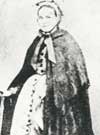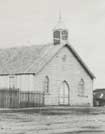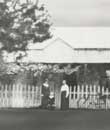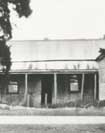Dadswell Family History
Generation 7
Thomas William Dadswell (1828-1908) and Sarah Elizabeth Holmes, Helena Aurora Scheer
On this page:
Ancestors of Thomas William Dadswell
Thomas' story
Key family dates
Photographs
Further information
Ancestors of Thomas William Dadswell
Robert Doudeswell 1560 > Robert Doudeswell 1606 > Edward Dodswell 1659 > Alexander Dodswell 1686 > Thomas Dadswell 1732 > James Dadswell 1786 > Thomas William Dadswell 1828
Thomas William's story
Thomas William Dadswell, born in Sussex, England, and his German-born wife Helena were the couple who migrated to Australia and gave their name to the Western Victorian community known today as Dadswells Bridge. Together they operated Dadswells Hotel while he also became involved in bridge and road building, saw milling, postal duties and community life.
Thomas was remembered by some of his grandchildren as a big man, very strong, with dark hair and a bushy beard. By the age of 12 he was working as a servant but he soon became a labourer on railway construction projects in England and Europe, learning civil engineering skills which would help him in his later life in Australia.
Thomas and Helena arrived in Australia in 1857 and had seven children. The family was living at Ledcourt Crossing, between Stawell and Horsham, by the early 1860s where Thomas was involved in a number of ventures, including timber milling, road making, bridge building and the hotel at Ledcourt Crossing, which was known as Dadswells Hotel. Gradually the locality became known as Dadswells Bridge.
As well as being the family home, Dadswells Hotel became a centre for community activity. Thomas Dadswell was postmaster (1869-1880), a school was located within the hotel building, community functions were held there, and it provided accommodation for travellers using horse-drawn coaches.
But in the space of four years, the family was shattered by four tragedies - Thomas' wife Helena died aged 42 in 1873, the eldest son Otto was nearly killed in a horse racing accident a year later, eldest daughter Martha died from measles in 1875, and the fifth child, Henry William, aged 12, died in 1877 from tonsillitis. At the same time, Thomas' business ventures faltered.
Thomas lived to the age of 80 and died while living with his daughter Helena Matilda Norwood at Tarnagulla in 1908. He was buried at Tarnagulla Cemetery. A more detailed history is provided below.
Early life
Thomas was the ninth child of a farming couple, James and Charlotte (Ovenden) Dadswell, and he was born at Mayfield, Sussex on 25 November 1828. James died in 1838 when Thomas was aged 10, and three years later the 1841 census shows Thomas was living as one of five servants at Freeman's Farm, Mayfield with a farmer, Thomas Marchant. The other servants included a Robert Ovenden, 15, possibly a cousin. At this time, Thomas' mother Charlotte is also shown living at Mayfield with three of her sons, James, Alfred and Charles. At the age of 13, on 20 March 1842, Thomas was baptised at St. Dunstan's Church, Mayfield along with brother Alfred who by then was aged 19.
Within a short time, Thomas moved to West Yorkshire where he worked as a railway labourer, probably on the construction of railway tracks and associated infrastructure. While there he entered into the first of his two known marriages. On 29 May 1848, when he was a 21-year-old bachelor, he married Sarah Elizabeth Holmes, a 19-year-old spinster, daughter of labourer Edward and Elizabeth (?) Holmes. The marriage took place at Honley Church near Huddersfield in West Yorkshire. The address of both the bride and groom was given as Gynn Lane, Honley, and the witnesses were a miner, James Dyer, and Maria Holmes, a sister of Sarah. Later that same year, Thomas was a witness when Maria and James Dyer married at the same church (for more information about the Holmes and Dyer families, see link at the foot of this page).
The 1851 census shows Thomas, then 23, living at 2 Weston Street, Bromley, Kent, with Sarah, 22. The census return gives Sarah's birthplace as Canterbury in Kent. Also living in the same house was William Stag, a widower, and both he and Thomas were listed as railway labourers. (At this time, Thomas' mother Charlotte is living with Edward Bassett and his family at Tonbridge, Kent).
Thomas and Sarah Dadswell moved again and in 1852 the couple had a son, James Thomas Dadswell, who was born at the family's home at 4 Robert Street, Mill Hill, Poplar, Middlesex, on December 26. On the birth certificate Thomas described himself as a labourer.
European life
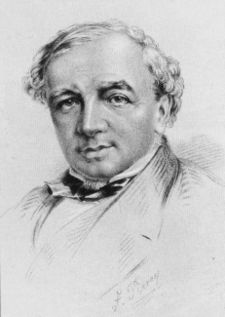
Thomas may well have been moving frequently to work on railway building projects around England and in Europe. He was widely believed by some of his grandchildren in Victoria to have worked as a surveyor or engineer for the English railway contractor Thomas Brassey (pictured at right). Brassey, a brilliant engineer, had extensive rail building and other engineering contracts in England, Europe, Canada, India, Australia and South America. Thomas' association with Brassey is supported by a story told by a grandson Tom Dadswell (1900 - 1984), who earlier in life had met a Charles Healey who had worked on an irrigation channel construction project at Dooen, near Horsham in the Wimmera region of Victoria. Healey said he was present when a visitor to the project recognised Thomas Dadswell and said he remembered him from a dyke project in Holland.
Certainly Thomas (and probably his wife Sarah) ended up living in Berlin, then part of the Prussian empire. In 1855, the then 2-year-old James Dadswell is recorded as dying on March 31 with his burial in Berlin on April 3.
Thomas Brassey certainly had railway construction projects in neighbouring Austria at this time and possibly Thomas worked on a section of the Vienna-Linz railway. At the time, the Prussian Army and Austria were at war, making construction difficult for the Brassey team ("Thomas Brassey", by John Gould, Shire Publications, 1975). This gives weight to a story told by Henry Dadswell (1894-1978) who said he had been heard that his grandfather Thomas had rowed a boat into a place being fortified by the Germans. He was arrested as a spy, and it took all of Brassey's influence to get his release from custody.
Thomas was thought by some of his descendents to have been able to speak in several languages including German, Russian, Italian and possibly Dutch and Portuguese. His German dictionary, with copperplate handwriting on the opening page (pictured below), remains in the family.
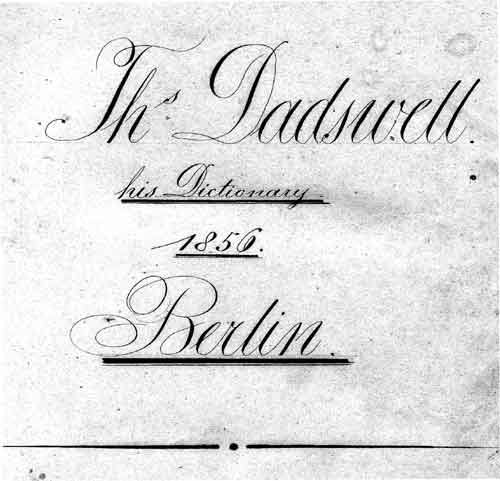
No trace has been found at this time of Sarah Dadswell being in Europe, but Thomas' presence in Berlin is further indicated by his presumed second marriage there in 1856, to Helena Mariane Aurora Scheer, daughter of architect Carl Friedrich Christoph and Anna Elizabeth (Tietz) Scheer. No marriage certificate has been located but the year and place of the marriage is noted on Helena's 1873 death certificate.
Moving to Australia
Thomas and Helena sailed from Liverpool on the west coast of England on 26 June 1857, aboard the John Lynn, a sailing ship of 1470 tons under Captain William Henry Ray, and which took unassisted passengers to Melbourne. Information from a number of sources show the ship had trouble during the voyage because of heavy weather, but Henry Dadswell could recall a letter at his home in Warrak, Victoria in which English relatives had remarked that the voyage of three months had been made in "remarkably good time." The passenger list included entries for Thomas Dadswell, describing him and his wife Ellen (sic.) as Irish. Thomas was also listed as a labourer. It was on this voyage that Thomas reputedly made by hand two violins, based on one made by James Perry of Back Lane, Kilkenny, Ireland, in 1783. The original violin and one of the copies are still held by the family; the second copy has long since been sold.
The John Linn arrived in Melbourne on 3 October 1857 and the following year the couple's first child, Charlotte Martha Ulricke Dadswell, was born - on 12 July 1858 while they were living in Vere Street, East Collingwood, in Melbourne. Thomas described himself on Martha's birth certificate as an engineer.
Shortly after Martha's birth the family moved to Moorabool in the Geelong area. At this time, the rail line from Melbourne was being extended westwards and the substantial Moorabool viaduct was being constructed, and Thomas may well have been working on it for a short time. The viaduct was not completed until 1862 but by 1859 Thomas was at Halls Gap, near Stawell. In partnership with John Folkes and Dave Mickle he started a saw pit, cutting timber by hand for use in buildings at Stawell. It was not long before they put up a timber mill, two of the saws being driven by a large water wheel.
Helena and Martha had remained at Moorabool where the couple's second child, Alfred Otto Dadswell, was born on 28 February 1860. Thomas registered the birth at Geelong in early April and probably moved the family to Pleasant Creek (now called Stawell) at this time, where he was listed in the rate books as having a dwelling in the Quartz Reef area, now known as Stawell West. In that year, a tender from Messrs Dadswell, Folkes and Mickle was accepted for the construction of the first Presbyterian Church erected in Pleasant Creek, a 28 ft. x 44 ft.wooden structure built at a cost of £275. It was opened on 19 August 1860.
Three of the couple's children were born during the stay at Pleasant Creek - Emma Elizabeth Dadswell on 28 September 1861, Charles Thomas Dadswell on 24 May 1863 and Henry William Dadswell on 19 February 1865. The birth certificate for Henry appears to be the first time that Thomas used the name of Thomas William Dadswell - until then he had identified himself only as Thomas Dadswell. Around this time, Thomas is believed to have been a senior member of the lodge although no records have been found to support this.
Civil engineering
By 1863, Thomas had established himself as an engineer in the area. In June of that year, Wimmera Shire Council requested he prepare plans and estimates for a bridge over the Yarriambiack Creek at Longerenong Station on the road to Glenorchy. Two months later, as agent for Messrs Geo Tilley & Co., contractors, he wrote to the Wimmera Shire Council "relating to their responsibility in regard to the repairing of the approaches to the Horsham and Lochiel bridges damaged by the recent floods" and in October he requested payment of the balance due on contacts 1 and 2 to Geo. Tilley.
In 1864, he formed a partnership with James McClounan in the contracting business and they obtained contracts with Wimmera Shire for various works in Horsham. This partnership does not appear to have lasted long as the following year Thomas and McClounan were separately submitting tenders for jobs with the Shire.
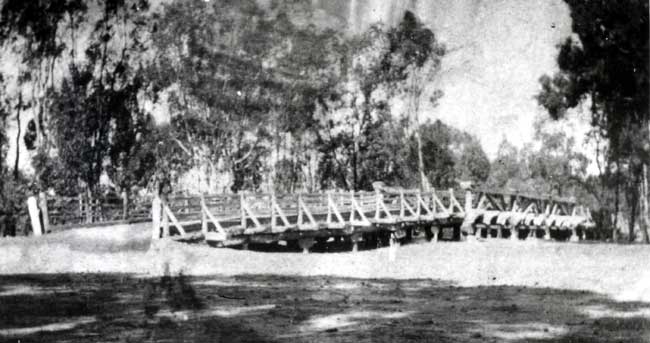
In 1865, he continued to obtain contracts with the Wimmera Shire and probably also with the Shire of Stawell, although no evidence has been found to support the latter. By this time also, he would have been employing a considerable number of people. As well, according to Shepherd's Gold (C.E. Sayers, Cheshires, 1966), in the year of the Victorian Land Act 1865 which released land to settlers, Thomas was operating a saw mill at Ashens, near Lubeck. No rate book for this year has been found but in 1866 he was shown as paying rates to the Shire of Stawell as a contractor and sawyer in the Parish of Ledcourt.
In 1865, a road was surveyed between Stawell and Horsham and Wimmera Shire decided to make the road passable to vehicles which meant a bridge had to be built over the Mount William Creek at Ledcourt Crossing. James McClounan, builder of Horsham, submitted a tender for £899.0.0. which was accepted in April 1866 and it is believed that Thomas designed the bridge and supervised its construction. It was a pile bridge of three spans, the centre span being semi-suspension. Its planking was of broad oregon beams, with heavy two inch bolts clamping the timbers together. The bridge was ready for use by early 1867.
From information obtained from the Lands Department files at Laverton, near Melbourne, it appears that Thomas started operating a saw mill in the Ledcourt area in 1865. He subsequently built a four room weatherboard dwelling measuring 25 feet by 12 feet with a back skillion on what was later to become Crown Allotment 113, and upon its completion moved the family from Stawell. He also built a weatherboard chaff house with a shingle roof and a men's hut, part weatherboard and part sawn slabs, with a bark roof. Their sixth child, Helena Matilda ('Tilda) Dadswell, was born on 12 May 1867 while they resided in this house.
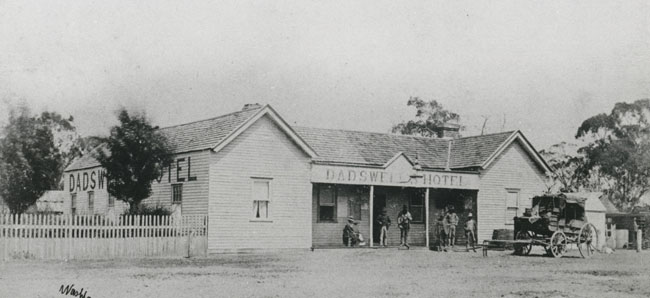
In 1868, the couple's youngest child, Ulricke Matilda (Rita) Dadswell was born at Stawell, on December 11. Her name, however, was shortly after changed to Ulrica Mary Ann, the name by which she was known for the rest of her life. Also in that year, Thomas applied for and was granted a seven year lease of Crown Allotment 194. He then commenced the building of the 16 room Dadswell's Hotel and on its completion, probably in 1869, moved the family into it. From subsequent events, it appears that Thomas borrowed from the Bank of Victoria to finance the construction. The house on Allotment 113 was then converted into the 'Dadswell Schoolhouse' where the children's education continued, Thomas employing his own teacher who resided in the house.
In 1868, he continued with his contracting business as well as operating a saw mill. It was probably about this time he began farming on the 46 acres of the hotel site and also the 79 acres on the opposite side of the road which he subsequently selected. The hotel was located on Crown Allotment 194 in the Parish of Ledcourt, on the south side of the Stawell-Horsham Road.
In July of that year, Thomas was prosecuted by the Shire of Wimmera for non-payment of rates. At the August meeting of the council, his cheque for £2.10.0. was received and also correspondence from J.G. Preswell, of Ararat, the Council's solicitor, "forwarding particulars of costs in the case of Council v. Dadswell." Also in 1868, Messrs Mantel and Kraefft of Stawell, joined Thomas in the saw milling business he operated on the 'New Horsham Road'. The minutes of the February 1869 meeting of the council stated "that the Shire Secretary informed Mr T.W. Dadswell that it has come to the knowledge of this council that he is in the habit of dragging logs over the Ledcourt Bridge whereby much injury had been done to the said bridge, and also informed him that should he continue to drag logs over said bridge after receipt of the secretary's letter he will be prosecuted."
Life at 'Dadswells'
In 1869, he continued successfully tendering for contracts with the Shire. Departmental records of that year show Thomas became postmaster when the Ledcourt Post Office was first established on 23 October 1869, and he remained in that post until it closed on 1 October 1880. Newspaper reports of the period indicate the hotel business was flourishing and included catering as well as the postal business. The Pleasant Creek News and Wimmera Advertiser of 23 April 1870 reported:
"From our Ledcourt correspondent:
Although held in one of the most secluded nooks in the Stawell Shire, the sports were well patronised, and witnessed by about 200 persons. The most remarkable feature of the assemblage was the number of little children present, and the question naturally arose 'where do they all come from?' I believe this query was asked often at mine hosts Dadswell, who invariably replied with one of those peculiar nods and winks which denote mystery. The course was cleared by about half past 6 p.m., when stewards and Pleasant Creek friends, to the number of about sixty, sat down to a sumptuous dinner, prepared in Mrs. Dadswell's usual style, and served in a booth specially erected for the occasion. After partaking of the 'needful', and duly acknowledging Mr. and Mrs. Dadswell's liberality, and endeavours, to conduce to the comfort of their guests, the stewards retired and settled the race matters to the satisfaction to all concerned. A ball followed."
Early in 1870, Thomas applied for and was granted a slaughtering licence from the council, indicating he was raising a considerable number of cattle, pigs and sheep on his holdings. His contracting business was also successful although, when tendering for one job, his cheque for £45.16.0. was returned by the Stawell Branch of the Bank of Victoria to the Wimmera Shire - "dishonoured." However, this matter was apparently cleared up as, upon payment of the balance of the contract when the work was completed, his £45.16.0. deposit was refunded. The Advertiser of 21 April 1870 carried an advertisement which read:
Ledcourt Bridge Saw Mill,
On the New Horsham Road
All sizes of Hardwood cut to order. Mining Companies supplied. Tongued and Grooved Planking for sheep washes, large quantities of 5 ft. Garden Palings always on hand.
Apply to Mantfl and Kraefft, Reefs, or Thos. W. Dadswell, Saw mill.
An enquiry from the Registrar General as to whether the saw mill of Mantel and Kraefft was still in existence was received by the Wimmera Shire Council at its June meeting. The secretary replied that the Collector of Statistics had returned the mill in the name of "Thomas Dadswell, the present owner". Also about June, Thomas appears to have run into trouble with a debt owing to a 'Sargood and another.' Sargood garnisheed Thomas' contract payments from the Wimmera Shire. Thomas didn't accept the action and summonsed the council to appear in the Supreme Court in Melbourne. Thomas lost the case and the judge directed the council to "settle the garnishee" and awarded it one guinea costs. Council subsequently forwarded the next payment of £128.14.0. due to Thomas to its solicitor with instructions to settle the "Judge's Order" and return the balance, together with his costs in the matter.
[This was the last meeting of the council recorded in its first minute book. Minute books from mid-1870 to 1915 were lost or destroyed when council moved to its offices in Firebrace Street, Horsham.]
Tom Dadswell (1900-1985) believed Dadswells Hotel was a stopping place for horse-drawn coaches, and certainly coaches were making the Stawell-Horsham (and beyond) run around this time. The hotel business prospered and Thomas became a storekeeper, building contractor and sawmiller, and he raised cattle, pigs, turkeys, etc. which he said were sent by road to Geelong markets and probably to Ballarat. About eighty hands were employed by Thomas around this time, according to grandsons Tom and Henry Dadswell.
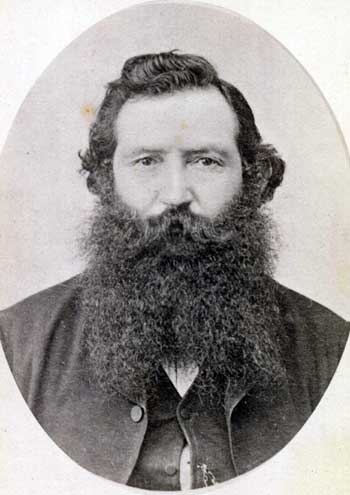
On 25 October 1871, the Board of Land and Works issued a certificate stating "This is to certify that substantial and permanent improvements to the value of one pound for every acre and fractional part of an acre contained in Allot. 194 in the Parish of Ledcourt and the agricultural district of Ledcourt leased to Thomas William Dadswell on 16th. September 1868 has been made on the said allotment before the end of the second year from the commencement of the term of the lease." A series of unexplained transfers of the lease then commenced, all being registered with the Board of Land and Works:
29 November 1871 - Transfer from Thomas William Dadswell to Herman Kraefft
1 February 1872 - Transfer from Herman Kraefft to James Laurence and John Adam of Melbourne
10 June 1872 - Transfer from Laurence and Adam to Thomas William Dadswell
11 June 1872 - Transfer from Thomas William Dadswell to Joseph Richardson and John Francis Richardson
10 March 1873 - Transfer from Richardson and Richardson to Samuel Williamson
14 March 1873 - Samuel Williamson, bank manager of Stawell, was registered as the proprietor of a leasehold estate for seven years from 16 September 1868.
On 24 September 1873, Williamson made an application for a Crown Grant which was issued on 15 November 1873. Williamson disposed of the land to John Davies, George Turner and Frederick Lloyd on 5 January 1874. However, Thomas Dadswell retained occupancy of the land and hotel until 1889 when he appeared to have finalised his affairs at Dadswells Bridge. Members of the family believe that at one time Thomas was offered a considerable sum (reportedly about £3000) for the hotel and business but rejected it.
Meanwhile, on 30 June 1870, he applied for a licence under Part II of 'The Land Act 1869' to occupy Allotment 113, declaring that he had placed corner markers on March 30. He gave his occupation on the application as hotelkeeper. The application was granted on 29 December 1870. On 29 December 1874 Thomas received a letter from the Office of Lands and Survey advising that they intended to "declare his license forfeited for non-payment of rent due on 29.2.1873 the same having been formally gazetted as in arrears on 13th. March 1874." Thomas replied, requesting that he be allowed to pay arrears and continue with the licence. Subsequent to this, the bailiff from Stawell visited the area for the purpose of reporting on improvements made on the land. He found that Thomas was operating his sawmill without the necessary sawmill licence. He recommended that "he be allowed to pay arrears subject to the sawmill site being excised and a license be taken out for the same under Section 47."
Further negotiations during 1874 and 1875 failed to resolve the dispute and on 4 February 1876 Thomas was called before the Local Land Board at Stawell where it was recommended that he be allowed to pay arrears and renew his licence. A letter to the Board on 17 August from one of its 'servants' stated: "Every means having been used to induce Dadswell to pay arrears without avail I have to suggest that the license be revoked ...". This was done by notice in the Government Gazette on September 22 whereupon Thomas, via his solicitor, made another belated appeal, hurriedly paying arrears of rent and sawmill licence. The matter then appeared to proceed smoothly and on 29 August 1877 he received a Crown Grant to Allotment 113. Once again he seems to have been in financial difficulty with the bank as, on October 25, the land was transferred to the Bank of Victoria, probably the only asset the bank could legally take at the time. But by 1879, Thomas was declared insolvent. This order was revoked late the same year.
The bank appears to have had some difficulty disposing of the land as Thomas purchased it back on 3 July 1882, also buying from the bank at the same time a building block in Dimboola. Thomas retained both properties until 1889 when he sold the Dimboola block to Eleanor Georgina Boyd and Allotment 113 was transferred to a Nicholas Rogan. Rogan probably also bought the hotel and other buildings on Allotment 194 from Thomas about this time and purchased the land from Davies, Turner and Lloyd in 1891. This appears to be the end of the Dadswell association with Dadswells Bridge.
Family tragedies
Perhaps some of Thomas's business set-back can be partly explained by family tragedies which occurred around this time. In 1873, his wife Helena died after a two
year illness, aged 42. She was buried in Stawell Cemetery, with her grave originally marked with an engraved wooden marker (pictured). At this time, the family of seven children ranged in age from three (Rita) to fourteen (Martha).
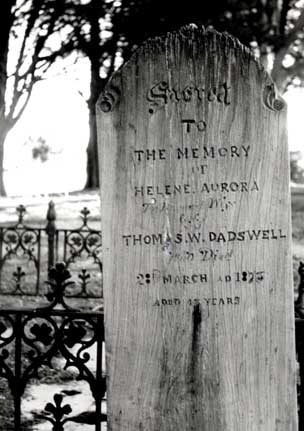
In 1874, horse riding almost claimed the life of his son Otto. At the age of 14, Otto was thrown from his horse when racing across a paddock with another youth. The horse caught a leg in a rabbit burrow and Otto crashed heavily to the ground. He suffered broken wrists, collar bone and ribs, and severe internal injuries and his doctor gave him a limited time to live - if he even recovered. But recover he did, although he carried through life a stoop and a hump behind the left shoulder that resulted from his injuries. Henry Dadswell (1894 - 1978) said he was told by his Aunt Lena (Helena Matilda Dadswell,a sister of Otto) that when Otto was injured, the man who organised the racing went and got drunk before getting the courage to tell Thomas about the accident. Lena said Thomas put a hand on each of the man's shoulders, lifted him up and shook him like a bundle of rags before throwing him into a corner.
In 1875, after nursing some of the family through illness, including almost certainly Otto, the eldest child, Martha, died from measles on May 21. She also was buried at Stawell in a grave alongside her mother.
In 1876, on July 13, a male child named Thomas Dadswell, was also buried in the Stawell Cemetery, aged 10 weeks. No birth or death certificate for this child has been located to indicate the parents of the child.
In 1877 the shrinking family suffered a further tragedy when Henry William, then age 12, died from tonsillitis at Dimboola on July 12. He was buried in the Dimboola Cemetery the same day.
Some family stories suggest Thomas became an alcoholic as a result of the tragedies in the family, although his grandchildren Tom Dadswell (1900-1985) and Fran Souter (1894-1984) had no recollection of this.
Thomas' hotel trade was initially built up because it served the road leading to Horsham and beyond, and it would have been a logical stopping place for many travellers, being half way between Stawell and Horsham. But by 1878, a decision had been made to route the railway not directly between Stawell and Horsham but further to the north through Glenorchy and Murtoa. The railway opened in 1879, taking much of the hotel trade with it and the business declined rapidly.
In 1881, Thomas was described as a saw mill proprietor, and it was probably at this time or the previous year that he went into another partnership, this time with a Mr. Feckler of Horsham. Fecklers operated a hardware and timber business in Horsham for many years. A saw mill was opened at Wartook with land, saw mill and buildings leased from the Crown. However, a dispute arose and Thomas was thought to have lost substantial assets, and the partnership was dissolved.
After the collapse of the Wartook venture, it is believed that Thomas returned to Dadswells Bridge (Ledcourt) and continued with contracting and farming, his son Charles probably looking after the reduced hotel trade.
Life in Horsham
In 1886, together with what remained of his family, Thomas moved to Horsham where he and Charles opened a timber and ironmongery business in Wilson Street. They lived in a rented dwelling, presumably on the site of the business. Thomas was also advertising his services as a surveyor from an office at that address.
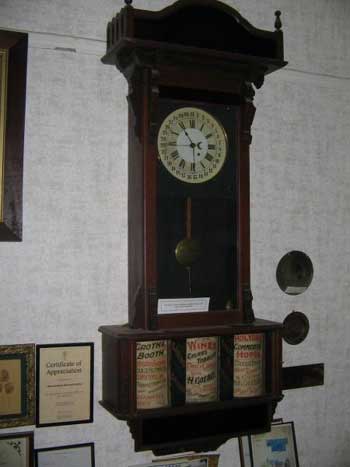
In 1889, he was employed as acting town engineer to the Borough of Horsham on a fee-for-service basis. He supervised a tramway construction contract from the stone quarries at McKenzie Creek to Horsham and also prepared plans and supervised construction work on a section of Kalkee Road, being paid a fee of 1.5% for preparation of plans and 4% for supervision. Some considerable difficulty was experienced with the Kalkee Road contract, probably due to weather conditions and the nature of the local basaltic soil, and at one stage Thomas asked to be relieved as engineer. However, the contractor was granted an extension of time and, on completion of the job, Thomas was given a bonus of £10 by the council because of the extra time taken. Thomas, in a report on the job, stated "he had considered it his duty to inflict a penalty of £26 on the contractor for late completion." The Council, however, decided to remit the penalty to the contractor. Thomas also appeared to have employed a man to help with the supervision. The council received a claim "from a man named English for £6.13.0. for supervising the Kalkee Road work." Thomas was asked to attend the next meeting of Council "to give any explanation required," but the matter appeared to have been cleared up as nothing was mentioned in the minutes of the next two meetings.
He continued throughout 1890 and until June 1891 in the position of acting town engineer. In that month Council appointed a new town clerk who was also to act as the town engineer. Thomas was an applicant for the position but was late submitting his application and, although he sent a letter explaining the reason for his late application, the mayor "decidely refused all late applications."
Picture: This 1890s clock, now in Warracknabeal & District Historical Society museum has advertisements on revolving spindles at its base. One advertisement reads:
T. W. Dadswell C.E.
Architect & Surveyor
Estimates Given
Wilson Street
Horsham
Just prior to this, in March 1891, a councillor returned from Warrnambool with a sample of scoria and details of a new method of footpath paving, "highly spoken of by the Warrnambool Town Engineer." Thomas was asked for a report on the material. At the April meeting he submitted his report "objecting to the material as being too porous and costly." Council, after a discussion, resolved "that expert be employed." This appears to have been the end of his association with the Borough of Horsham except for advice on small matters, a payment of £1.1.0. in December 1895 being recorded in the minute books.
During 1893-95, Thomas was living in another rented property in Urquart Street, Horsham, and in 1896-97 he was resident in Darlot Street, where his granddaughter Helena Florence Dunbar was born. He was probably living in semi-retirement at that stage, being in his late 60s. He left Horsham about the end of 1897 or early 1898 and turned up at his son Otto's place at Warrak, near Ararat. He was enrolled at that address on the 1899 Federal Referendum Roll, giving his occupation as 'civil engineer.' He probably moved his few belongings to Warrak, as one of Otto's grandsons, Bill Dadswell (1929-1993) could remember Thomas' drawing desk and instruments being there in the 1930s and 1940s.
During 1895-1900, Earl Brassey - son of the railway contractor Thomas Brassey - was governor of the colony of Victoria, and Henry Dadswell (1894-1978) could recall a story that Thomas - because of his work with Brassey Sr in Europe - was invited to Government House in Melbourne. The story went that Thomas had to buy a suit so he could make the visit.
End times
Early in the 1900s Thomas again moved, this time to the home of his daughter Helena, who had in 1891 had married Sidney Norwood. Thomas lived with this family when they had a hotel at Deniliquin in New South Wales and in 1905 moved with them to a hotel at Shelbourne, near Bendigo, in Central Victoria. At the time, he conducted a shop in the hotel, selling books and stationery. He moved with them again when they bought the Tarnagulla Hotel, also near Bendigo, in 1907. One of the Norwood family, Fanny (Fran) Souter (1894-1984) years later could still recall Thomas, then 79 years old, with his own room at the hotel. The children would take him a bowl of gruel in the evenings. At that time, he wore glasses and still played the violin.
On 2 October 1908, Thomas made out a will, signing in shaky handwriting. He bequeathed "unto my dear daughter Helena Matilda Norwood all my real and personal estate." On October 5, after a three week illness, he passed away and was buried at Tarnagulla, in a grave also occupied by one of the Norwood children, who died as an infant. However, a bush fire has destroyed the enclosure erected around their grave and today a stone marks his gravesite.
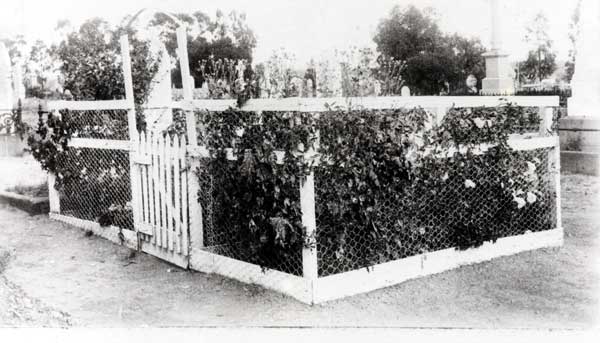
Reporting on his death, the Tarnagulla & Llanelly Courier of 10 October 1908 states:
Death of Mr. T. Dadswell
During the week, the hand of Death has removed from our midst another of the old pioneers of the State, in the person of Mr Thomas Dadswell, father of our esteemed townswoman, Mrs S. H. Norwood, of the Tarnagulla hotel. The deceased's illness was of short duration, extending over a period of only three weeks, and although he received the best possible nursing at the hands of his daughter and her family it was of no avail, and he passed quietly away on Monday afternoon, the immediate cause being the rupture of a blood vessel on the lung.
Mr Dadswell was 84 years of age, and a native of Brighton, England. He arrived in this State in 1854, and has resided in the Wimmera district during the greater portion of half a century. He was a civil engineer by profession, and one of his first works was the Bendigo railway line. Since then he has been engaged on other important works in the State. Of late he has resided in Tarnagulla, and whilst here he superintended the erection of the Tarnagulla hotel. He leaves a grown family of three sons and two daughters, all of whom have the deepest sympathy of this district. The funeral took place at the local cemetery on Wednesday, the Rev. E. Schweiger conducting the burial service, and Mr. Roper had charge of the funeral arrangements.
Key family dates
| Thomas William Dadswell born 25 Nov 1828 - died 5 Oct 1908 |
married 1. Yorkshire, England 29 May 1848 |
Sarah Elizabeth Holmes born ca1829 - died ? |
Child -
1. James Thomas Dadswell born 26 Dec 1852 - died 31 Mar 1855
| Thomas William Dadswell born 25 Nov 1828 - died 5 Oct 1908 |
married 2. Berlin, Prussia 1856 (?) |
Helena Mariane Aurora Scheer born 20 April 1831 - died 28 March 1873 |
Children -
1. Charlotte Martha Dadswell born 12 July 1858 - died 21 May 1875
2. Alfred Otto Dadswell born 28 Feb 1860 - [married Emma Lewin] - died 16 June 1946
3. Emma Elizabeth Dadswell born 28 Sept 1861 - [married Henry Fitzroy Bell] - died 26 July 1955
4. Charles Thomas Dadswell born 24 May 1863 - [married Susan Broadwood] - died 17 July 1940
5. Henry William Dadswell born 19 Feb 1865 - died 12 July 1877
6. Helena Matilda Dadswell born 12 May 1867 - [married Sidney Herbert Norwood] - died 8 March 1945
7. Ulrica Mary Ann Dadswell born 11 Dec 1868 - [married Robert Francis Dunbar] - died 7 June 1955
Photographs
Click on any picture to see a larger size photograph.
Further information
Sailing the John Linn to Australia — the Hazardous Trip
Sarah Holmes (first wife of Thomas Dadswell)
Helena Mariane Aurora Scheer - a German Ancestor
Thomas & Helena's children (generation 8)
James Dadswell (generation 6, father of Thomas William Dadswell)
